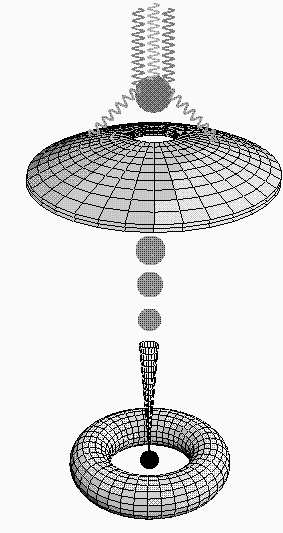 Cannonballs ejected
from a supernova, courtesy A. De Rujula,CERN
Cannonballs ejected
from a supernova, courtesy A. De Rujula,CERN
Since the 1950s a lot of work was expanded on the idea that the
ashes
or "remnants" of supernovae produce the major part of cosmic rays.
However, there is now a large body of experimental results,
that can be forced into agreement with this idea only with difficulty.
Most importantly, experimental limits on the cosmic-ray density in
the
remnants are orders of magnitude lower, than straightforwardly expected
if the remnants make most of cosmic rays. A review of this situation
was given by me in November 2001 [astro-ph/0111555
].
There are strong indications that specialists in the field know that
the "standard model" of cosmic rays
is wrong. In a recent review of Biermann
and Sigl the term "supernova remnant"
does not appear a single time. Voelk
summarises in a recent review:
"The search - under the SNR lamp post - for Galactic CR origin,
one of the problems of the century
has made remarkable progress ... during the last years."
Yet "officially" the standard model is upheld and as a result there
is no activity to search for
alternatives. Since the work of Plaga and Dar mentioned below,
not a
single novel approach to the problem of the origin of low-energy cosmic
rays (a problem of the century!)
has been published. This seems almost surrealistic to me.
A possible solution to this conundrum has come from a new
model for the so called gamma-ray
bursts, (see here
for a transcript of a
radio broadcast by the German station SWR2, where some colleagues and
I
contributed interviews to the question of gamma-ray bursts (in German))
the cannon-ball model [astro-ph/0008474
] developed by Arnon
Dar from the
Technion and Alvaro
De Rujula from CERN .
If this model is correct, a hefty share of all supernovae
eject masses of plasma (the "cannon balls") into a very small opening
angle (a few hundreds of a degree) with energies that are a factor
10 - 100 larger than the one of "remnants" - thus forming narrow
"jets".
I find it likely that their model contains important elements of truth,
some reasons for this belief can be found in my recent publication:
Rainer Plaga,
"The cepheid-like relationship between variability and luminosity
explained within the " cannonball model " of
Gamma-Ray bursts [astro-ph/0012060
] "
(A&A 370,351 (2001)). The complete refusal of the community to
deal with
the work of Dar and de Rujula up to now (November 2002) is a complete
and utter riddle to me.
Recently a very strong polarization was detected in the prompt
gamma-rays of
a strong GRB. The fact that this strong polarization was predicted in a
paper from
1994 by G.Shaviv and A.Dar was not mentioned in the discovery paper by Nature.
In 1999 Arnon Dar
and Rainer Plaga
proposed
in the publication
"An alternative source of cosmic rays at all energies [astro-ph/9902138]"
(A&A,349,259 (1999)) that, what would later be called
cannonballs,
are the
long sought sources of cosmic rays. During 2000 Rainer Plaga developed
this idea further in the manuscript:
" A possible Universal Origin of Hadronic Cosmic Rays from
Ultra relativistic Ejecta of Bipolar Supernovae[astro-ph/0106033]
" (New Astronomy, 7,317 (2002))
click here for
controversial
discussion about this paper).
Many basic questions remain unanswered even in this manuscript,
and some answers given there will prove to be wrong.
However, that extremely narrow
jets from a hefty fraction of
supernovae produce
most of the Galactic cosmic rays seems
virtually certain to me.